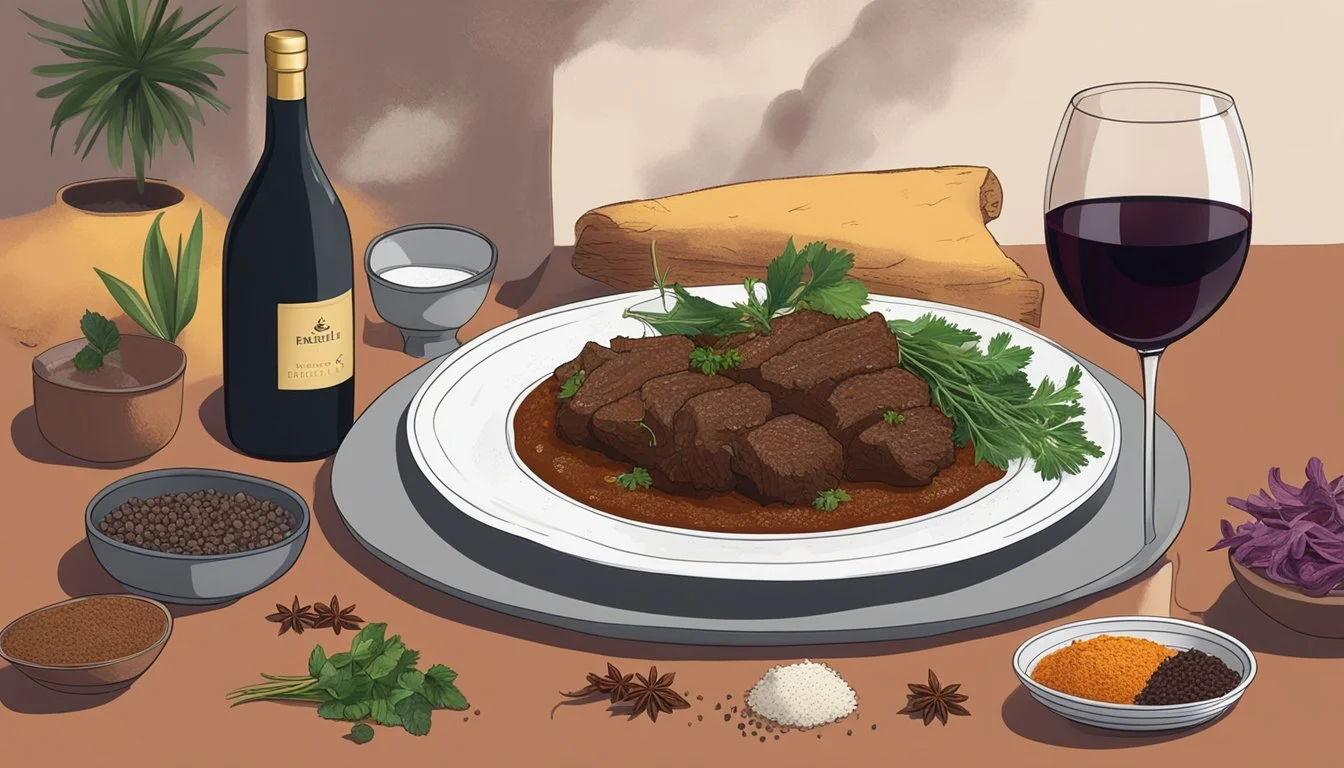What Wine Goes Well with Beef Rendang?
Pairing Tips for an Exquisite Meal
Beef (What wine goes well with beef?) rendang, a celebrated Indonesian dish, is known for its rich and complex flavors, resulting from a slow cooking process that infuses the beef with a fragrant blend of spices and coconut milk. The dish offers a symphony of sweet, spicy, and savory notes, with a hearty texture that makes it a satisfying meal on its own. However, the culinary experience of beef rendang can be further enhanced when accompanied by the right wine.
Choosing a wine to complement beef rendang requires consideration of the dish's bold taste and spiciness. A full-bodied red wine, such as a Pinot Noir or Cabernet Sauvignon, can match the intensity of the dish while providing a harmonious balance of flavors. These wines bring enough structure, fruitiness, and tannins to the table, which not only stand up to the richness of beef rendang but also help to accentuate its layered spice profile.
For enthusiasts partial to white wines, a selection with sufficient body and a hint of oak, like an oaky Chardonnay, can be quite apt. The creaminess and depth of such a wine can complement beef rendang's complexity while providing a pleasant contrast that cuts through the spice, making it a versatile choice for diverse palates. The guiding principle is to select a wine that resonates with the dish's aromatic depth without overwhelming its nuanced flavor tapestry.
Understanding Beef Rendang
Beef Rendang is a hallmark of Asian cuisine, renowned for its rich flavors and tender, slow-cooked beef. It stands as a testament to the complexity of spices and intertwining of culinary traditions.
Key Ingredients
The foundation of Beef Rendang lies in its key ingredients which include:
Beef: Typically a tougher cut, slow-cooked to tenderness.
Coconut Milk: Provides creaminess and tones down the spiciness.
Spices: A blend that often contains galangal, lemongrass, and other regional spices.
Lemongrass and Galangal: Essential for authentic flavor; lemongrass adds citrus notes, while galangal contributes a warm, spicy kick.
Flavor Profile
Food lovers celebrate Beef Rendang for its flavor profile that is remarkably balanced despite the boldness. Attributes include:
Spiciness: Manifests from the various spices used, offering a warm and pleasant heat.
Savory and Richness: The combination of beef, spices, and coconut milk creates a depth of savory richness.
Complex: Every bite brings a symphony of sweet, spicy, and savory, revealing the skill behind its preparation.
Preparation and Cooking Method
Preparation and cooking method are crucial in achieving Beef Rendang's signature taste. They involve:
Slow Cooking: Beef is simmered in the spice-infused coconut milk for hours until it absorbs the flavors and becomes fork-tender.
Stirring: Occasional stirring is required to prevent sticking and ensure even cooking.
Reduction: Over time, the sauce reduces, concentrating the flavors around the beef, until it's dark and rich in texture.
The Basics of Wine Pairing
In selecting a wine to complement a dish, the goal is to achieve harmony between the flavors of the food and the characteristics of the wine.
Wine Characteristics
Wines can vary greatly in texture, flavor, and aroma. The body of the wine, whether it is light, medium, or full-bodied, is often determined by levels of alcohol and tannin. Red wines like Cabernet Sauvignon are typically full-bodied with a bold profile, while white wines, such as Chardonnay, might exhibit a fruity character and aromatic quality. A wine's acidity contributes to its freshness and can provide a high acidity that contrasts well with sweet or rich dishes (What wine goes well with rich dishes?).
Wine Attribute Description Body Full-bodied wines have rich and complex flavors. Medium-bodied wines are balanced. Light-bodied wines are more refreshing and lighter in flavor. Tannin Tannins provide structure to red wines, contributing to astringency and complexity. Acidity Wines with high acidity can cut through fatty or sweet flavors. Aroma Every wine has distinct aromatic fingerprints that can complement or contrast food ingredients.
Fundamentals of Pairing
The fundamentals of pairing revolve around the synergy between wine and food. A successful pairing considers the dominant taste profiles, such as sweet, salty, bitter, or umami, and how they will interplay with those found in the chosen wine. When considering pairing, dry wines might complement dishes with a bit of sweetness, and the boldness of red wines often holds up against heartier dishes. The concept of an aroma bridge suggests that wines and dishes with shared aromatic compounds can enhance one another when paired together.
Red Meat: A rich and complex dish like beef rendang, with its savory and spicy layers, pairs well with bold reds that contain complementary spices and tannins.
White Wine: When pairing with white wine, a full-bodied, oaky Chardonnay with good structure might be a suitable match for its ability to balance the dish's rich flavors.
Red Wine Selections
Pairing red wines with beef rendang enhances the dish's rich and spicy profile. The robust flavors of the meal are well-matched with full-bodied red wines that provide complementary fruit notes and the firm structure of tannins.
Cabernet Sauvignon
California, notably from the Sonoma region, produces Cabernet Sauvignon that is both bold and assertive. The full-bodied nature of Cabernet Sauvignon, with its high tannins and strong dark fruit flavors, stands up excellently against the richness and spiciness of beef rendang.
Shiraz and Syrah
Australia is renowned for its Shiraz, especially from the Barossa Valley. Shiraz and Syrah, though essentially the same grape, yield a wine that matches the goods of beef rendang. The peppery notes and bright fruit flavors of Australian Shiraz contrast nicely with the spiciness of the dish. French Syrah can also be an excellent choice, presenting a more earthy profile with robust tannins.
Other Notable Reds
For those seeking alternative red wine options, a range of varietals can compete with the boldness of beef rendang. Wines like Zinfandel, Malbec, and Merlot often come with a balance of fruit and spice that will not be overwhelmed by the dish. Pinot Noir, particularly more full-bodied ones, can pair nicely as well, although they are generally lighter than the previously mentioned reds. Cabernet Franc, another noteworthy option, offers a spicy and robust profile that echoes the rich spices used in beef rendang.
White and Rosé Wine Pairings
When selecting white or rosé wines to pair with the robust and spicy flavors of beef rendang, one should consider wines with enough acidity to cut through the richness and those that can complement the dish’s complex spiciness.
Full-Bodied White Wines
Full-bodied white wines like an oaky Chardonnay, particularly from regions like Napa, possess a creamy texture that can stand up to the density of beef rendang. They should be selected for their ability to balance the dish’s spices without overwhelming its intricate flavors.
Off-Dry and Sweet Whites
Off-dry wines, like German Riesling or Gewürztraminer from Alsace, can be exceptionally harmonious with beef rendang. Their sweet notes tend to soothe the heat, while their natural high acidity provides a refreshing contrast.
Sweetness: Complements the spiciness
High Acidity: Cuts through the richness
Sauvignon Blanc and Alternatives
Sauvignon Blanc is a versatile choice; a Chilean Sauvignon Blanc or one from New Zealand offers a crisp profile that can refresh the palate after each bite of the spicy beef rendang.
Crisp: Enhances the dining experience by cleansing the palate
New Zealand/Chile: Offers vibrant fruit flavors
Other Wine Styles
Other white wines and rosé wines can also be paired with beef rendang:
Dry Riesling: A crisp and aromatic option
Chenin Blanc: Often shows a balance of sweetness and acidity
Sparkling Wines: The effervescence can provide a palate-cleansing effect
Rosé: A dry, medium-bodied rosé can echo the spiciness while providing a refreshing counterpoint
Regional Wine Recommendations
Choosing the right wine to accompany beef rendang enhances the dining experience by complementing the dish’s complex flavors. This section provides specific recommendations from renowned wine-producing regions, ensuring a harmonious pairing with this rich and spiced Indonesian dish.
Australian Favorites
In Australia, wine connoisseurs often reach for a bold Barossa Shiraz or a vibrant McLaren Vale Grenache. These full-bodied red wines from South Australia harmonize with beef rendang's spiced profile, thanks to their ripe fruit flavors and hint of oak aging.
Barossa Shiraz: Known for its peppery and dark fruit notes.
McLaren Vale Grenache: Exhibits spicy berry qualities that play well with rich dishes.
French Classics
France offers a treasure trove of wines that can stand up to the robust flavors of beef rendang. A Burgundy Pinot Noir, with its earthy and floral notes, or a well-structured Rhône Syrah, enriched with smoky and hearty undertones, are stellar choices.
Burgundy Pinot Noir: This wine brings subtlety and grace, yet enough body to complement the rendang.
Rhône Syrah: Perfect for adding a smoky echo to the beef's spice-infused sauce.
New World Wines
Exploring New World wines, one can find exceptional pairings for beef rendang. A California Cabernet Sauvignon from regions like Sonoma, with its bold tannins and berry flavors, or a New Zealand Pinot Noir, known for its aromatic intensity and supple texture, create a delightful balance.
California Cabernet Sauvignon: Offers a robust structure that matches well with the dish's complexity.
New Zealand Pinot Noir: Provides a fruit-forward counterpart to the savory spices in rendang.
Serving and Enjoyment
When serving beef rendang, the robust flavors and slow-cooking method of the dish are greatly complemented by the right wine selection. This Indonesian speciality is known for its significant blend of spices, including chili, and its rich, caramelized sauce, whose complexity can be enhanced with an appropriate wine pairing.
Full-bodied red wines are typically recommended for their ability to match the intensity of beef rendang. The tannins in red wine can withstand the richness of the sauce and the slow-cooked meat, providing a taste experience where neither the dish nor the wine is overshadowed.
Pinot Noir: Delivers a balance of fruitiness and earthiness that can bring out the dish's complex spices.
Cabernet Sauvignon: Known for its boldness, it can hold its own against the flavorsome sauce and chili heat.
For those preferring white wines, an oaky Chardonnay with its full body and rich texture could provide a pleasant contrast. The wine's inherent butteriness and hints of vanilla might soften the spice's impact and introduce a delightful interplay of flavors.
While choosing a wine, one must also consider the color and presentation of the dish. The deep brown hue of beef rendang is visually coherent with the dark tones of red wines, potentially adding to the dining experience's aesthetic harmony.
Lastly, for those including vegetables as a side, they should note that wines like Zinfandel or Syrah, known for their medium body and fruit-forward profile, complement green vegetables well, as they contribute to taming the spice without overpowering the palate.
In summary, the enjoyment of beef rendang with wine hinges on selecting a varietal that supports and contrasts the dish’s rich flavor profile, ensuring a harmonious and enhanced dining experience.





